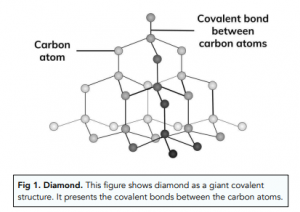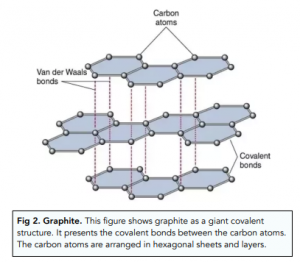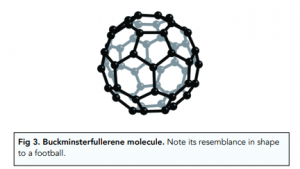Bonding - Carbon Allotropes (A-Level Chemistry)
Carbon Allotropes
Allotropes of Carbon
Allotropes are different molecular or crystalline forms of the same element, resulting in different physical properties.
Carbon is an example of an element that exists as different allotropes. Each carbon atom has an outermost electron shell with 4 electrons. This means that each carbon atom needs to gain 4 more electrons to gain a full outer shell of electrons. The carbon atoms gain a full outer shell through covalent bonds in which they form two different macromolecular structures: diamond and graphite
Diamond
- In diamond, each carbon atom forms four covalent bonds with four other carbon atoms. In diamond, each carbon shares electrons with four other carbon atoms. This means that each carbon atom forms a single covalent bond with four other carbon atoms.
- Diamond is a very hard substance due to its strong covalent bonds. The strong covalent bonds in diamond means that it is very difficult to break. It is actually known to be the hardest naturally occurring substance found on Earth. As a result of its hardness, diamond is often used to coat drill bits.
- Diamond has a high melting and boiling point. The covalent bonds in diamond are very strong, therefore a large amount of energy is needed to break them.
- Diamond is a good conductor of heat. Diamond is a good thermal conductor because of the strong covalent bonds it consists of. This means that when you heat the diamond, the vibrations of thermal energy are rapidly transferred through the substance.
- Diamond is insoluble in both water and in organic solvents. Diamond does not dissolve in any solvent. This is because the attraction between the carbon atoms in diamond by covalent bonds is a lot stronger than the attraction that could occur between the solvent molecules and carbon atoms in diamond.
- Diamond is a poor conductor of electricity. Diamond cannot conduct electric because the outer electrons found in each carbon atom are fixated between the atoms in covalent bonds. This means there are no free electrons that can move around and carry charge

Graphite
- In graphite, each carbon atom forms three covalent bonds with three other carbon atoms. In graphite, each carbon shares electrons with three other carbon atoms. This means that each carbon atom has one outer electron that is not involved in a covalent bond. This ‘fourth’ electron becomes delocalised and is free to move around.
- The carbon atoms in graphite are organised into sheets of hexagons. In graphite, the carbon atoms are arranged into sheets which means that graphite has a layer structure. The sheets are arranged into layers and the layers are joined together by weak intermolecular forces called ‘van Der Waals forces’.
- Graphite is soft slippery substance because it consists of layers that can slide. Unlike diamond, graphite is arranged in layers and sheets of carbon atoms. The layers in graphite can easily slide over each other because there are weak intermolecular forces holding them together. Due to its slippery nature, graphite act be used in pencils and as a dry lubricant.
- Graphite has a high melting and boiling point. The covalent bonds in graphite are very strong, therefore a large amount of energy is needed to break them.
- Graphite is insoluble in both water and in organic solvents. Graphite does not dissolve in any solvent. This is because the attraction between the carbon atoms in graphite by covalent bonds is a lot stronger than the attraction that could occur between the solvent molecules and carbon atoms in graphite.
- Graphite is a good conductor of electricity. Graphite can conduct electricity because it contains delocalised electrons which are free to move between the sheets of carbon atoms and carry charge.
- Graphite has a low density because the distance between the layers is large. As the layers in graphite are held together by weak intermolecular forces, the layers are far apart.

Other Allotropes of Carbon
Graphene
Graphene is another allotrope of carbon consisting of a single layer of graphite. It is an extremely strong and light material.
Buckminsterfullerene
- Buckminsterfullerene (C60) consists of tiny hollow spheres of covalently bonded carbon atoms. These spheres can measure as little as 0.1 and 100nm. Buckminsterfullerene is therefore an example of a carbon nanoparticle.
- Each carbon atom is bonded to 3 other carbons. The covalently bonded carbon atoms form rings in the shape of a hexagon or a pentagon. In total, the carbon atoms in buckminsterfullerene are arranged at the corners of 20 hexagons and 12 pentagons.
- Buckminsterfullerene has a relatively low sublimation point. It directly turns into a gas from its solid state without becoming a liquid first. This is due to the very weak Van de Wall forces between individual buckminsterfullerene molecules.
- Buckminsterfullerene is soft. Again this is due to the very weak Van de Wall forces between individual buckminsterfullerene molecules and the little energy required to overcome them.
- Buckminsterfullerene can conduct electricity. Due to the presence of delocalized electrons. Extent of delocalisation is less than in graphite so its electrical conductivity is worse.

An allotrope is a different form of an element that has a different physical structure, but the same chemical composition.
The different forms of carbon are called allotropes and include diamond, graphite, fullerene, and amorphous carbon.
Diamond is a crystal structure made up of carbon atoms arranged in a tetrahedral structure, resulting in a strong, hard and transparent material. On the other hand, graphite is made up of stacks of graphene layers, where the carbon atoms are arranged in hexagonal patterns, resulting in a soft, slippery, and opaque material.
Diamond is used in jewelry and cutting tools, while graphite is used in pencils and as a lubricant.
Fullerene is an allotrope of carbon in the form of a closed cage structure, consisting of 60 or more carbon atoms arranged in hexagonal and pentagonal patterns.
Amorphous carbon is a form of carbon that lacks a long-range ordered structure. Unlike other carbon allotropes, amorphous carbon does not have a well-defined crystal structure and appears glassy or crystalline in appearance.
The study of carbon allotropes is important because it helps to understand the different physical and chemical properties of different forms of carbon and how they can be used for various applications. This knowledge is crucial for fields such as materials science, nanotechnology, and electronics.
The study of carbon allotropes is approached in A-level Chemistry through a combination of theoretical and practical work. Students learn about the structure, properties, and uses of each form of carbon, as well as how they can be synthesized and characterized. Practical work may include synthesizing and characterizing different forms of carbon, and exploring the properties and uses of each form.
The different types of bonding in carbon allotropes include covalent bonding in diamond and graphite, and van der Waals forces in fullerene.
The bonding in carbon allotropes affects their physical properties, such as hardness, electrical conductivity, and solubility. For example, the strong covalent bonding in diamond results in a hard and transparent material, while the weak van der Waals forces in fullerene result in a soft and spherical structure.





Still got a question? Leave a comment
Leave a comment